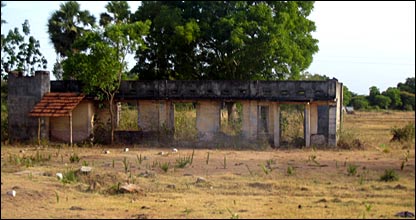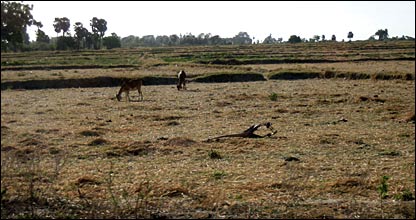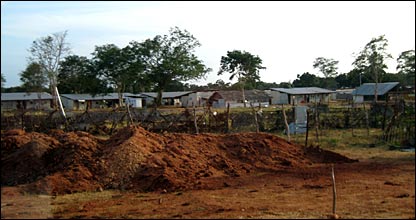Broken, torn buildings tower over the tiny UNHCR tents on the gardens and court yards. Hanging clothes, pots and pans and carry bags scattered around the land show signs of civilian life.
 |
The alert and watchful eyes of weary soldiers scanned every vehicle passing through the checkpoints |
Thirty years of war has taken a lot from the lives of the Mannar farmers and they still await a sense of security.
“Be careful and watch your mouth. The government security forces are vigilant and they do not like us talking to outsiders," my hosts warned.
The alert and watchful eyes of weary soldiers scanned every vehicle passing through the checkpoints.
They are tired but seem to be friendly. Especially after the moment they identify someone as a Sinhalese visitor from the south.
They are eager to share their war stories, explain the fighting and hardship they have undergone in the area. They see themselves still as victors.
'Tragic' civilian life
Civilian life is still a tragedy to many. There is nothing left on the ground for the people who return from the camps where they were interned until recently.
 |
There is nothing left on the ground for the people who return from the camps where they were interned until recently |
“We left with a tractor full of stuff in 2006 and came home with two shopping bags”, Mr A told me.
When the Tigers retreated, Mr A had to leave his village near Madu Church with his three children and wife and follow the orders of the LTTE.
He managed to escape to the army controlled area in 2009 just before the war ended.
“The Army sent us to Manik farm and we were there for year and two months. We got our land back but the house was razed to the ground” A said.
 |
 We left with a tractor full of stuff in 2006 and came home with two shopping bags We left with a tractor full of stuff in 2006 and came home with two shopping bags
 Resettled IDP Resettled IDP |
He lived in Murunkan and was brought up by a Sinhalese woman. Fluent in Sinhala Mr A worked in the south. Now he is labouring for 600 rupees a day.
“We get oil, rice, lentils, flour and sugar. We do not have money to buy vegetables. We feed our kids with a pulp made out of murunga (drums sticks) leaves and flour. Sometimes we go on hunting. We do not have guns and the jungles are full of mines. So we have to live on iguanas and other small animals”.
The story is same for many returnees. Many houses were razed to ground. Some live on tiny tents right next to their ruined houses.
They all have to begin their lives from scratch and according to them the support they need is not readily available.
'Extend the suffering'
“The Government promised us they will build our house, but still they did not do anything” Mr A told me.
According to the reports from the area the government redevelopment plan costs about 650,000 rupees per house but only 325,000 rupees is available.
 |
Broken, torn buildings tower over the tiny UNHCR tents on the gardens and court yards. Hanging clothes, pots and pans and carry bags scattered around the land show signs of civilian life |
“The aim is to build non permanent houses and extend the suffering of the Tamils” a prominent Tamil leader told me.
“There is no planning, no consultation from local communities or leaders about resettlements, this is worse than the Tsunami but no one is doing anything to ease the suffering of the people” he added.
“If the government is not able to deliver services then it should allow non governmental agencies to intervene, but the Government is not doing that because they are confiscating land and conducting a so-called resettlement plan with a view to implement colonising projects”.
Near Arippu, Muslims have been resettled and local Tamils show their displeasure saying “Kachal” meaning it is disturbing the peace in the area.
Locals say that displaced Muslims were resettled before the Tamils in the area.
 |
 Be careful and watch your mouth. The government security forces are vigilant and they do not like us talking to outsiders Be careful and watch your mouth. The government security forces are vigilant and they do not like us talking to outsiders
 |
In Tirukeshwaram Sinhalese constructors are busy mending roads and reconstructing the damaged temple structures.
The brilliant glossy colours of the nearby Mahathitha Vihara are an example for resurgence of Buddhist temples in the former strong hold of the LTTE, a symbol that does not sit well with local Tamils.
Constructed and maintained by the military Mahathitha Vihara has two resident monks. According to security service personnel, the former leader of the Hela Urumaya, archaeologist Ellawala Medhananda Thero, has confirmed the historical existence of Mahathitha Vihara.
“Now the Tirukeshwaram Temple is challenging the claim as they say we have built the temple in their land” says a member of the military who is stationed in the temple.
Sinhala road names
The propagation of Buddhist shrines is evident throughout roads I followed to Jaffna. Not only that streets and roads were named after heroic Sri Lankan servicemen.
I saw a road named after Gamini Kularathne – Hasalaka Viraya in Vedithalative. Despite the local civilian population being Tamil, the signs of the road were in Sinhala only.
“The army and navy confiscated lands on the grounds of security and they are trying to wipe out our culture and heritage from the area” a person who wants to remain anonymous told me.
The defeat of the LTTE is bringing more miseries to the already wounded Tamils. Local residents who almost lost everything do not have any energy, political organisation or civil movements to oppose such moves.
“People lack basic goods to sustain their day to day life so they cannot bother about the politics” a leading clergyman in the area told me.
It is apparent that Tamils are forced to accept what the Colombo administration wants but the strong resentment to such impositions inevitably delay the prospects of peace in Sri Lanka.
The government is reconstructing the roads and improving the infrastructure. It is widening the roads and building the bridges to link the South.
Yet bunkers located every 500 meters and the continuous presence of the military give an air of a military state without any bridges to link the communities.
I felt that the watchful eyes of the security personnel and the weary manner of the civilians both ask the same question of how long the guns will remain silent. |  Home
Home Archives
Archives Home
Home Archives
Archives